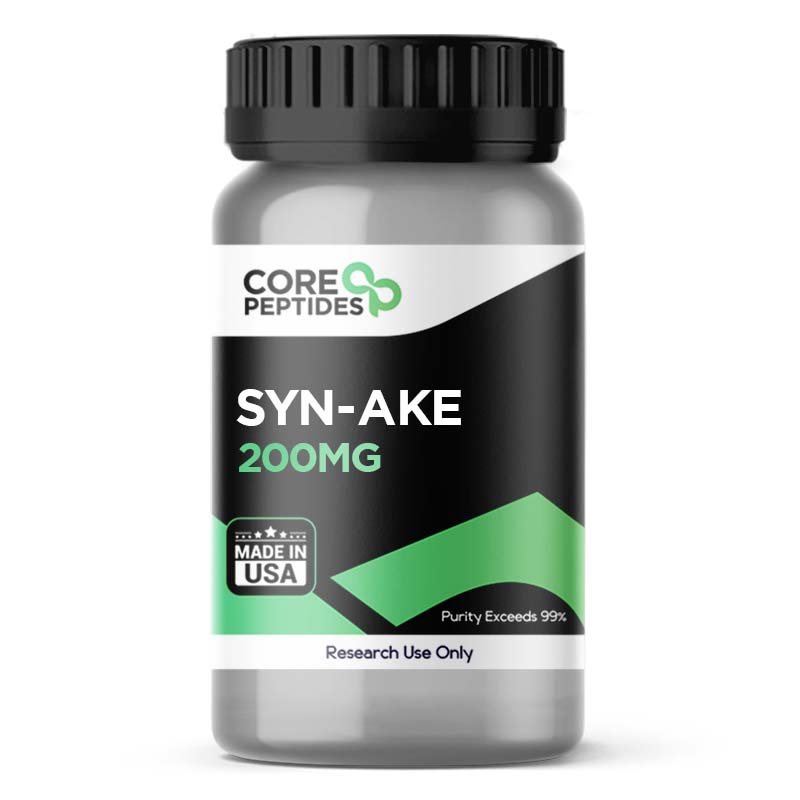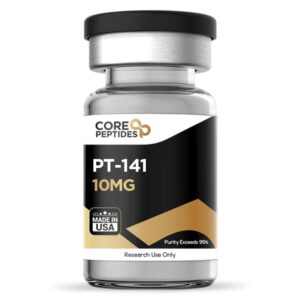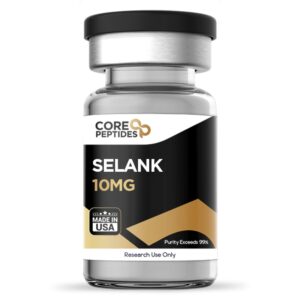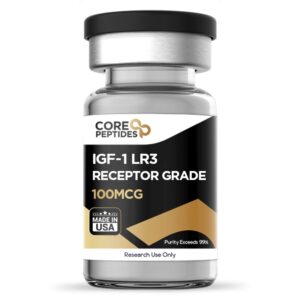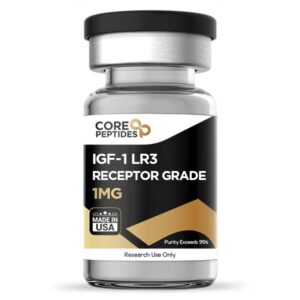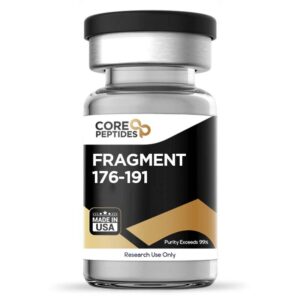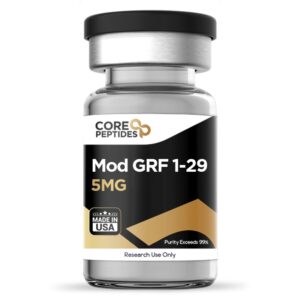Syn-AKE (200mg)
$165.00
Size: 200mg
Contents: Syn-AKE
Form: Lyophilized powder
Purity: >99%
SKU: P-SYN-AKE
FREE Shipping on $200+ orders
Discount per Quantity
| Quantity | Discount | Price |
|---|---|---|
| 5 - 8 | 5% | $156.75 |
| 9 + | 10% | $148.50 |
Syn-AKE
Syn-AKE is a synthetic peptide with the sequence beta-alanyl-L-prolyl-3-aminomethyl-L-alanine benzyl amide acetic acid known as tripeptide-3. The structure of Syn-AKE is composed of the amino acids alanine, proline, and diamino butyrate, which are linked by peptide bonds.(1) The peptide is designed to mimic the activity of Waglerin-1, a polypeptide. Waglerin-1 is a muscle relaxant that is considered to block the action of acetylcholine in the neuromuscular junction, leading to a decrease in muscle contractions.
When developing Syn-AKE, researchers aimed to develop a peptide with similar activity on muscle contractions as Waglerin-1. The peptide’s intended mechanism of action is temporarily inhibiting muscle contractions, which typically leads to a decrease in the depth of wrinkles on the skin of test subjects. This compound has been extensively researched for its potential anti-aging properties for the skin of various species, including reducing fine lines and wrinkles, improving skin texture, and increasing skin hydration solely because of its muscle-relaxing properties.
Chemical Makeup
Molecular formula: C23H37N5O7
Molecular weight: 495.57 g/mol
Other known titles: Tripeptide-3, Syn-Ake acetate, SYN-AK, DTXSID40231699, EX-A3743
Research and Clinical Studies
Syn-AKE Peptide Mechanism of Action
Syn-AKE has been reported by researchers to mimic the action of Waglerin-1.(2) Waglerin-1 has been considered to have muscle-relaxant properties. According to researchers, this component is a 22-amino acid polypeptide, and may be potentially selective for the form of nicotinic acetylcholine receptors (nAChRs).(3) The nACh receptors transmit signals from nerve cells to muscle cells, ultimately leading to muscle contractions. By blocking the activity of nAChRs, Waglerin-1 apparently prevents the release of acetylcholine and blocks muscle contraction. Waglerin-1 is also suggested to have modulating impacts on the brain's neurotransmitter gamma-aminobutyric acid (GABA) receptors. These receptors are involved in regulating the activity of neurons and by modulating them, Waglerin-1 may cause significant risks in research settings.
Contrastingly, initial research suggests Syn-AKE cannot affect GABA receptors in the brain and may lack the risks of Waglerin-1. Syn-AKE was designed to mimic the activity of Waglerin-1 by targeting the same nAChRs in the neuromuscular junctions. Specifically, Syn-AKE is a tripeptide that contains a sequence of amino acids similar to the region of Waglerin-1 that binds to nAChRs.
Syn-AKE is thought to have great permeability through the skin and bind to the nAChRs in the muscles beneath it, possibly preventing them from responding to acetylcholine. Researchers suggest that the peptide may be particularly impactful against expression lines by relaxing facial muscles. According to experimental research, the peptide "was able to reduce the frequency of innervated muscle cell contractions by 82% (...) after 2h of [presentation]."(4)
The antagonism of Syn-AKE towards the nAChRs may be reversible.(5)(6) Such a reversal may indicates that the potential of tripeptide-3 on the receptors are temporary and can be reversed once the peptide is no longer present.
Syn-AKE Peptide and Fine Lines, Wrinkles
According to researchers, Syn-AKE may induce an immediate minimization of muscle contraction, reducing fine lines and wrinkles.(7)(8) A three-month study including 37 female subjects aged 33 to 45 with mild-to-moderate wrinkles reported that Syn-AKE appeared to exhibit both immediate and long-term potential.(9) Assessments indicated statistically significant improvements in wrinkles shortly after presentation and at months 1 and 3.
One of the largest studies conducted on Syn-AKE compared its potential with other peptides and a placebo in 45 test subjects. Syn-AKE was reported to exhibit some potential, gradually exhibiting greater action after repeated presentation and reaching more than 50% after four weeks. Researchers suggested that Syn-AKE "showed up to a 52% reduction in the appearance of wrinkle size in test volunteers after a 28-day application of a 4% formulation to the forehead twice a day"(10)(11)
Syn-AKE peptide is available for research and laboratory purposes only. Please review and adhere to our Terms and Conditions before ordering.
References:
- Balaev, A. N., Okhmanovich, K. A., & Osipov, V. N. (2014). A shortened, protecting group free, synthesis of the anti-wrinkle venom analogue Syn-Ake exploiting an optimized Hofmann-type rearrangement. Tetrahedron Letters, 55(42), 5745-5747.
- Molles, B. E., Tsigelny, I., Nguyen, P. D., Gao, S. X., Sine, S. M., & Taylor, P. (2002). Residues in the epsilon subunit of the nicotinic acetylcholine receptor interact to confer selectivity of waglerin-1 for the alpha-epsilon subunit interface site. Biochemistry, 41(25), 7895–7906. https://doi.org/10.1021/bi025732d
- Gorouhi, F., & Maibach, H. I. (2009). Role of peptides in preventing or treating aged skin. International journal of cosmetic science, 31(5), 327–345. https://doi.org/10.1111/j.1468-2494.2009.00490.x
- Reddy, B., Jow, T., & Hantash, B. M. (2012). Bioactive oligopeptides in dermatology: Part I. Experimental dermatology, 21(8), 563–568. https://doi.org/10.1111/j.1600-0625.2012.01528.x
- Munawar, A., Ali, S. A., Akrem, A., & Betzel, C. (2018). Snake venom peptides: Tools of biodiscovery. Toxins, 10(11), 474.
- TATARINGA, G., & ZBANCIOC, A. M. (2021). Antirid peptides in cosmeceutical formula. Romanian Journal of PHARMACEUTICAL PRACTICE| Vol. XIV, 58(3).
- Chhipa, N. M., & Chaudhari, B. (2012). Toxin as a Medicine. Journal of Current Pharmaceutical Research, 9(1), 11-8.
- Trookman, N. S., Rizer, R. L., Ford, R., Ho, E., & Gotz, V. (2009). Immediate and Long-term Clinical Benefits of a Treatment for Facial Lines and Wrinkles. The Journal of clinical and aesthetic dermatology, 2(3), 38–43.
- Reddy, B. Y., Jow, T., & Hantash, B. M. (2012). Bioactive oligopeptides in dermatology: Part II. Experimental dermatology, 21(8), 569–575. https://doi.org/10.1111/j.1600-0625.2012.01527.x
- Pai, V. V., Bhandari, P., & Shukla, P. (2017). Peptides as cosmeceuticals. Indian Journal of Dermatology, Venereology and Leprology, 83, 9.

